JRDG Company Special – Model 725/725 s2 and 625/625 s2
Model 625 (stereo)
2011-2015
Retail price in 2013 in the Netherlands 17.250 euro
Model 625 s2 (stereo)
2015-2022
Retail price in 2016 in the Netherlands 21.000 euro
Also used in Marten Mingus Quintet review
Also used in Analog Domain review
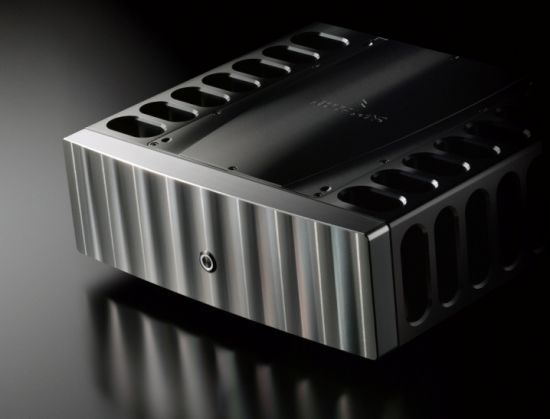
Model 725 (mono)
2012-2015
Retail price in 2013 in the Netherlands 35.500 euro
Model 725 s2 (mono)
2016-2018
Retail price in 2016 in the Netherlands 45.000 euro
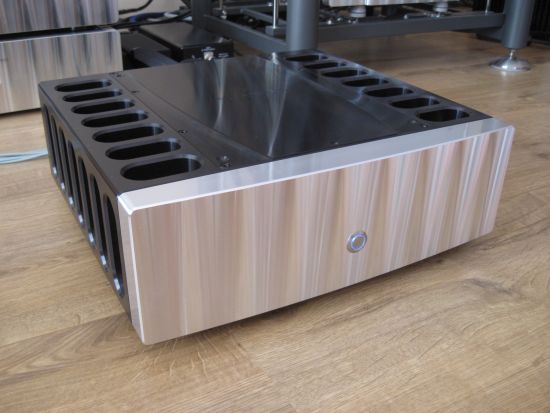
Back to class A/B
For the higher-end models, Rowland has returned to class A/B! Power supplies are a smart implementation of switched power, PFC and big capacitors.
Precision machined from a single block of non-resonant aircraft-grade aluminum, the Model 625 features a unique composite circuit architecture incorporating separate Class AB voltage and current gain blocks with no overall negative feedback and virtually free of internal and external EMI field contamination and mechanical vibration.
According to the manufacturer, the Model 625 delivers a sensuous grain-free musicality of unparalleled transparency and low-level resolution that blossoms from a rich velvety silence and blossoms into the pure enjoyment of your listening experience.
For a while, the 925 was no longer available in the Netherlands. In the meantime, the 725 got introduced. Was it to be the replacement for the big 925? Now we know it was not, but for a while it seemed that Rowland has phased out the 925, judging from its absence from the 2012 brochure. Too energy-consuming? Not compliant with EU regulations? Who will tell? Fact is, the 825 became available again (I even heard a pair at a demo) in 2013.
Precision machined from two single blocks of non-resonant aircraft aluminum, the Model 725 features a unique composite circuit architecture incorporating separate Class AB voltage and current gain blocks with no overall negative feedback.
The Model 725 features mil-spec ceramic circuit boards, high current copper bus bars, a power supply incorporating 4-pole capacitors and power factor correction, combined to deliver a life-like grain-free musicality of breathtaking transparency.
625/725 and 825/925 differences
The 725’s use ceramic boards and some other novel tricks, which are said to make them sound more nuanced and transparent than the 625. While the 625 and 725 on their basic levels share similar technology, both being “traditional” analog bipolar transistor types, the 925, and I assume also the 825 which looks like a spin-off from the 925, are actually switch mode amplifiers using Pascal modules at their core, augmented with a lot of extra power regulation.
Ron Gaston information
Ron, the proprietor of Black Forest Audio in Black Forest (CO), long time Rowland dealer, has extensive experience with every Rowland amp since the original M7. Here is what Ron wrote on a forum about M8 and M9 versus M825, M925, and M625:
“The Model 8/9 amps are big, rich and earthy in presentation. They are not, however, a match for the 825/925 in soundstage, detail or palpable realism. They seem downright sluggish in comparison. I believe [even] the 625 to be superior in nearly every respect to these older, very great amps.” Ron further explains that only in the bottom end authority M9 variants do outperform the little M625.
HFA
While I can imagine that the big model 9 sounds a little slower, I can testify that the model 6’s absolutely do not sound slow at all. In a direct comparison with the 725’s, the sixes seem to be just as detailed and refined as the later models, but they are just more relaxed with it and don’t throw the stage in your face. I do agree that compared to the sixes, the 725s sound more upbeat and lively, and they’re also more powerful. Read the full 725 review here.
Series 2
Apparently, the 625 was brought closer to the performance of the 725, allegedly making the 625 s2 sound almost as good as the 725. Actually, having heard both the 625 s2 and the 725’s, I feel that they sound quite different: the 625S2 warmer and smoother and the 725’s cleaner and drier.
The same was done later for the 725 apparently acquiring some of the advancements learned with the model 925. However, we may never know as the 725(S2) has been taken out of production early 2018.
The 625 Series 2 incorporates many of the same technical features of the 725 amplifiers. Similar to the 725, the 625 S2 signal circuitry is built upon a Rogers ceramic circuit board laminate material for lower dielectric absorption and energy storage. The 4-Pole filter capacitors used in the 725 power supply have also been included in the S2, significantly reducing power supply output noise. The maximum output power has been increased from 300 to 325 watts per channel at 8 ohms.
Precision LED-based current sources have been implemented throughout the amplifier circuitry, along with 0.1% thin film SMD resistors for more stable operating points and lower noise. Custom designed Lundahl input transformers are implemented with a higher turns ratio and wound with Cardas high purity copper wire. Input circuitry includes an additional linear phase 2 pole filter to effectively attenuate all out-of-band signals from any source, including DSD spurious noise. Cardas gold/Teflon/rhodium XLR input connectors are carried over from the 725. Newly developed error-correction circuitry has been incorporated around the entire amplifier, making a total of three independent error-correction techniques used to decrease all forms of distortion throughout the entire audio bandwidth.
Unlike M725 and M625, which have a mild propensity to emitting very soft, spurious HF noise from the speakers whenever power is cycled on/off (not when switching to/from standby), M925 are apparently extremely quiet. A forum post reads: “When the front-mounted momentary contact switch is operated to turn the amps to full power, there is only the internal “Klump” from a relay switch, followed after a second or two by an almost inaudible “tick” from the speakers. When the power button is operated again to place the amps back on standby, there is no noise at all from the speakers or from the amps”.
Model 625 Pictures
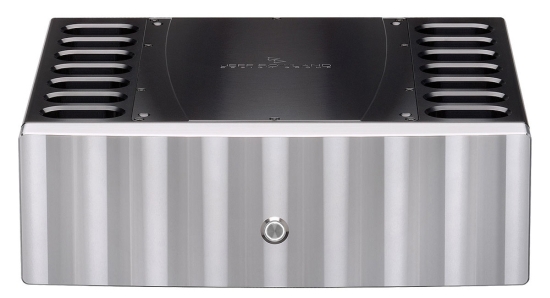
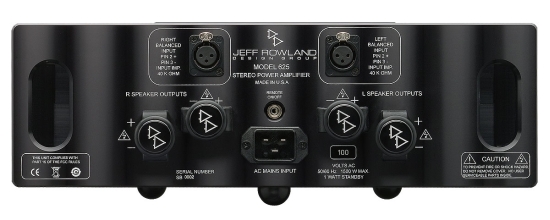
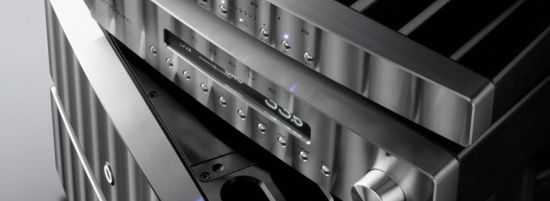
Beautiful stack of Aeris, Corus, 725’s
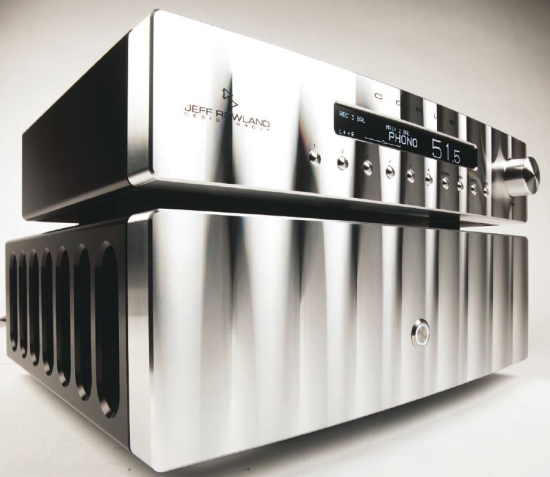
625 With Corus on top
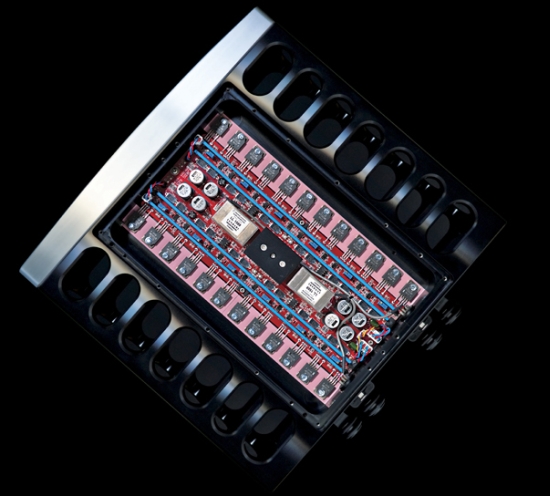
625 inside – top side
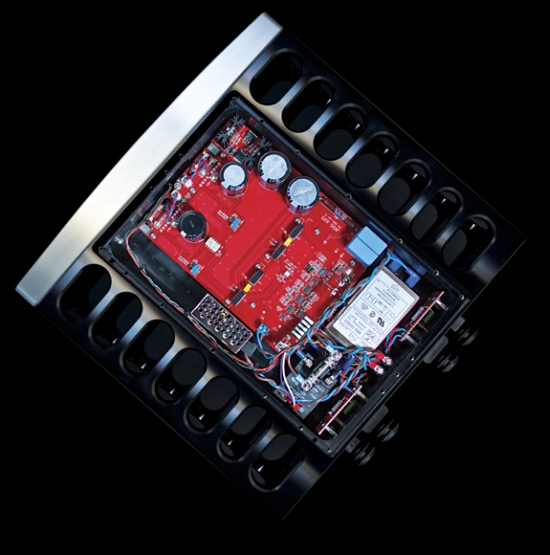
625 inside – bottom side
Model 725 Pictures

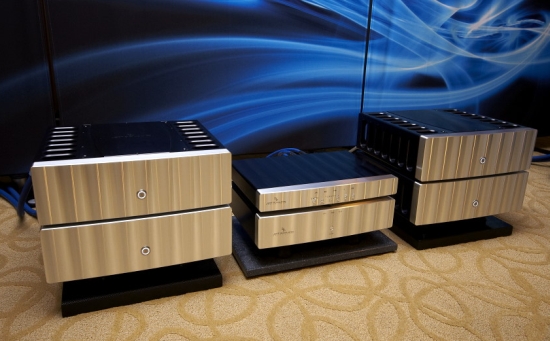
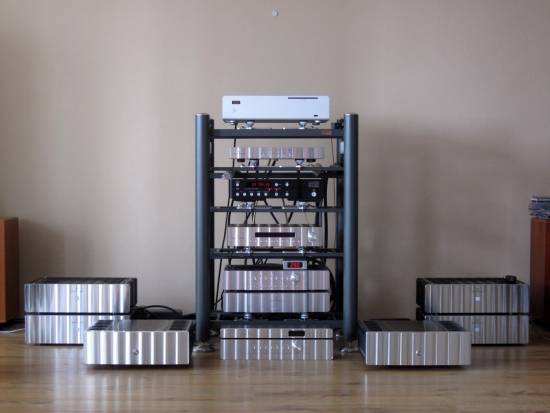
725’s during a HFA review
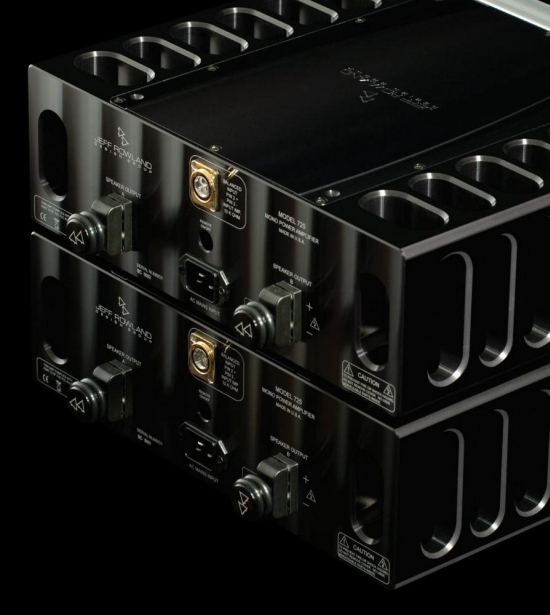
Double speaker terminals for easy bi-wiring
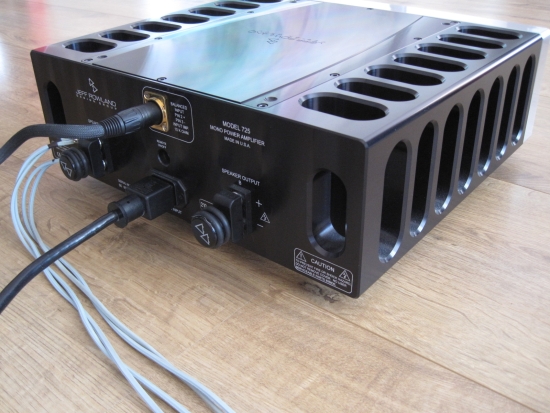
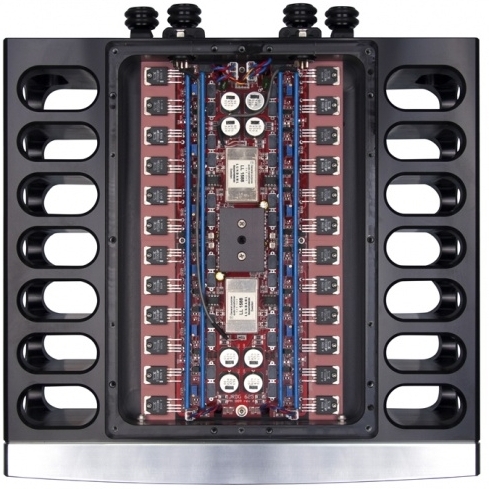
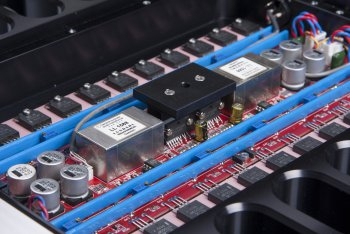
625 inside – top side
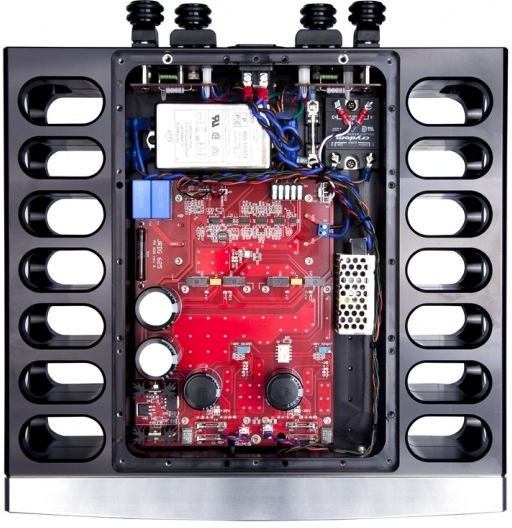
625 inside – bottom side
Model 625 Features
Machined Aluminum Chassis
Precision-machined chassis with integrated heatsinks, milled from a solid block of aircraft-grade 6061-T6 aluminum, provides exceptional thermal heat transfer/dissipation, RFI/EMI shielding, and resonance control.
Composite Circuit Architecture
Unique composite circuit architecture incorporating separate Class AB voltage and current gain blocks with no overall negative feedback, delivers a sensuous grain-free musicality of unparalleled transparency and low-level resolution.
Balanced Topology
Inherent cancellation effects of balanced topology implemented throughout all power and input/output circuits ensures greatly reduced distortion and noise under dynamic signal conditions.
High Current Copper Bus-bars
High current, dual polarity, ultra low impedance copper bus-bars distrubute both power supply input current and signal output current, virtually eliminating intra-circuit EMI signal contamination, greatly reducing internal wiring, while increasing circuit board rigidity.
High-Precision Surface Mount Components
Extensive use of Lead (Pb)-free, low temperature coefficient, active and passive surface-mount components results in significantly smaller loop areas, reduced circuit capacitance and inductance, and introduces less noise than conventional leaded components.
Transformer-Coupling and Isolation
Transformer coupled input circuitry provides universal component compatibility and virtually eliminate ground loop noise and RFI/EMI. Transformer coupling ensures identical amplifier overall gain when using unbalanced input adapters.
Power Factor Correction
Power Factor Correction (PFC) in the power supply reduces AC line harmonic noise pollution and increases AC line power utilization to 99%.
High-Efficiency Switch-Mode Power Supply
Highly efficient, compact, lightweight, 1500 watt DC switch-mode power supply provides optimum voltage regulation for all circuits and operating conditions, and allows for quiet operation over a wide range of AC mains power sources.
Dual-Position Speaker Terminals
Dual CE approved speaker output terminals, in both horizontal and vertical orientation, require no tools for secure, low resistance connections, and allow for easy bi-wiring applications.
Flexible 20 amp AC Power
20 amp AC power inlet accepts a wide variety of after-market high-performance power cables.
Front Panel Standby Button
Illuminated front panel push-button switches the amplifier into standby mode (< 1 watt consumption).
Rear Panel Remote Jack
12V 3.5mm jack on rear panel permits amplifier power on/standby switching in remote and home theater applications.
Self-Leveling Supports
Removable 3-point self-leveling Delron chassis supports provide high frequency mechanical noise isolation.
Model 625 Technical Specifications
Stereo power amp
Output Power
300 watts @ 8 ohms
550 watts @ 4 ohms
Frequency Response
5 Hz – 350 kHz
S/N Ratio
95 dB, ref. 1.0 watt @ 8 ohm load
Output Noise
< 55 ìv, 20 Hz – 20 kHz, unweighted
Crosstalk
> 91 dB @ 1 kHz, 74 dB @ 20 kHz
Input Impedance
10k ohms
THD + Noise
0.005% @ 1 kHz, 8 ohms
Damping Factor
> 200, 20 Hz – 20 kHz
Overall Gain (Balanced or Unbalanced)
27 dB
Common Mode Rejection Ratio
> 90 dB, 20 Hz – 20 kHz
Absolute Phase
Non-inverting Pin 2 Positive
Inputs
1 pair balanced (XLR)
Outputs
2 pair parallel binding posts per channel
Power Consumption
Idle 100 watts
Standby 1 watt
Amplifier Weight
54 lbs. / 24.5 kg
Amplifier Shipping Weight
64 lbs. / 29 kg
Overall Amplifier Dimensions (h/w/d)
5.75” x 15.5” x 16.25” / 146mm x 394mm x 413mm
Model 725 Features
Machined Aluminum Chassis
Precision-machined chassis with integrated heatsinks, milled from a solid block of aircraft grade 6061-T6 aluminum, provides exceptional thermal heat transfer/dissipation, RFI/EMI shielding, and resonance control.
Ceramic Circuit Boards
All audio circuits are implemented on mil-spec, multi-layer, low dielectric constant, Rogers™ ultra-rigid ceramic circuit board substrate for extremely low energy retention and absorption. Large low impedance ground plane areas for extended internal star-grounding.
Composite Circuit Architecture
Unique composite circuit architecture incorporating separate Class AB voltage and current gain blocks with no overall negative feedback, delivers a sensuous grain-free musicality of unparalleled transparency and low level resolution.
Balanced Topology
Inherent cancellation effects of balanced topology implemented throughout all power and input/output circuits ensures greatly reduced distortion and noise under dynamic signal conditions.
High Current Copper Bus-bars
High current, dual polarity, ultra low impedance copper bus-bars distribute both power supply input current and signal output current, virtually eliminating intra-circuit EMI signal contamination, greatly reducing internal wiring, while increasing circuit board rigidity.
High-Precision Surface Mount Components
Extensive use of Lead (Pb)-free, low temperature coefficient, active and passive surface-mount components results in significantly smaller loop areas, reduced circuit capacitance and inductance, and introduces less noise than conventional leaded components.
Transformer-Coupling and Isolation
Transformer coupled input circuitry provides universal component compatibility and virtually eliminate ground loop noise and RFI/EMI. Transformer coupling ensures identical amplifier overall gain when using unbalanced input adapters.
Power Factor Correction
Power Factor Correction (PFC) in the power supply reduces AC line harmonic noise pollution and increases AC line power utilization to 99%.
High-Efficiency Switch-Mode Power Supply
Highly efficient, compact, light weight, 1500 watt DC switch-mode power supply provides optimum voltage regulation for all circuits and operating conditions, and allows for quiet operation over a wide range of AC mains power sources.
Parallel Binding Posts
Dual CE approved speaker output terminals require no tools for secure, low resistance connections, and allow for easy bi-wiring applications.
Flexible 20 amp AC Power
20 amp AC power inlet accepts a wide variety of after-market high-performance power cables.
Front Panel Standby Button
Illuminated front panel push-button switches the amplifier into standby mode (< 1 watt consumption).
Rear Panel Remote Jack
12V 3.5mm jack on rear panel permits amplifier power on/standby switching in remote and home theater applications.
Self-Leveling Supports
Removable 3-point self-leveling Delron chassis supports provide high frequency mechanical noise isolation.
Model 725 Technical Specifications
Mono power amp
Output Power
330 watts @ 8 ohms
650 watts @ 4 ohms
Frequency Response
5 Hz – 350 kHz
S/N Ratio
95 dB, ref. 1.0 watt @ 8 ohm load
Output Noise
< 55 µv, 20 Hz – 20 kHz, unweighted
Crosstalk
> 91 dB @ 1 kHz, 74 dB @ 20 kHz
Input Impedance
40k ohms
THD + Noise
0.004% @ 1 kHz, 8 ohms
Damping Factor
> 200, 20 Hz – 20 kHz
Overall Gain (Balanced or Unbalanced)
27 dB
Common Mode Rejection Ratio
> 90 dB, 20 Hz – 20 kHz
Absolute Phase
Non-inverting Pin 2 Positive
Inputs Balanced (XLR)
Outputs 2 parallel binding posts
Power Consumption
Idle 85 watts
Standby 1 watt
Amplifier Weight
54 lbs. / 24.5 kg (each)
Amplifier Shipping Weight
64 lbs. / 29 kg (each)
Overall Amplifier Dimensions (h/w/d)
5.75” x 15.5” x 16.25” / 146mm x 394mm x 413mm (each)
More Jeff Rowland
Jeff Rowland Company Special Main Page
Jeff Rowland Company Special Power Amplifiers
Hi Christiaan
How HOT runs the JR 625?
I own a Pass Labs 250.8 but have only a small music room and the Pass gets to hot.
Will I get less heat from the JR 625?
Do you have experiences with Pass gear and could you say anything about the sound differences?
Regards from Vienna
Reinhard
When you get a 625, do make sure that you get a 625 S2. The updated version sounds a lot better but also gets hotter than the original 625. It is a class AB amp but has a relatively small case and A LOT of transistors that are heavily biased into class A, so it gets quite hot as well. The class AB Pass X250.5 got similarly hot but a small class A Pass amp that I tried (XA30 or XA60, not sure which one) got significantly hotter still than the 625 S2. Not having used the 250.8 I can’t say for sure how they would compare to the Rowland but I have a feeling that it may not be significantly less hot. If you want amps that do not get hot, what springs to mind is Bryston, NuPrime and Mola-Mola. The latter two are Class D and sound very different from Pass but I think you might be surprised how close the latest “cubed” SST Brystons come to the Pass sound, at very reasonable prices.
Soundwise, Pass and Rowland are very different.
Here’s a review in which I describe the differences between the X250.5 and the model sixes: https://www.hifi-advice.com/blog/review/analog-reviews/amplifier-reviews/pass-labs-x250-5-stereo-power-amp/
In my last few Audio History articles I compare various amps, including Pass: https://www.hifi-advice.com/blog/review/loudspeaker-reviews/hfa-audio-setup-history-27-speakers-so-far-aug-2017/
Hi Christiaan
thanks for this detailed infos.
Will have a look for Bryston.
I am not searching for an amp that that gets NOT hot, just one which gets LESS hot.
Perhaps this is one which a lower rate of Class A, but still Class A?
If you are looking for less heat than Pass, as indicated, I don’t think that a 625 S2 will be less hot. Next I would look into Bryston. Class AB, smooth, warm sound and does not get very warm. Any Class A amp with decent power that I tried gets hotter than the 625 S2.
Hi, I think about to buy either 725 or 625 S2. You compared both amps and characterized 725 as being dry and clean in comparison (although the sound signature of Jeff Rowland normally is the opposite). As dry and clean are rather have negative attributes I assume you prefer the 625 S2 over the 725 by a large extend. Am I right? Thanks! Regards, Oliver
Hi Oliver, that should be read in the context of my then system: the Model 6 with BPS 6 and me coming from a long history of classic JRDG gear. In an absolute sense, 725’s are not dry. They have the familiar smooth Jeff Rowland signature but are faster and more accurate which exhibits, among others, in tighter bass and more precise treble which can lead to the perception of them being relatively dry – when coming from classic Rowland gear. I’ve not compared the 725 and 625 directly but have heard the latter on multiple occasions, also in the V2 version and I do have a feeling that this amp sounds sweeter and rounder than the 725’s and thus more in line with the classic Rowland sound.
Hi Christian
I’m evaluating to buy either 725 S2 or 825. Pre would be Criterion and speakers Vienna Acoustics The Music.
Which one would you recommend me and why. Many thanks
Well, the 725’s are class A/B designs that sound in line with the model sixes but a little tighter and with better focus and articulation. The 825 is a Pascal design which I have only heard at shows but I would say that it follows the line of other Pascal amps in the Rowland repertoire but with added finesse. It likely also has better control which I suspect the Vienna Music speakers will appreciate.
So, basically, 825 = tighter, cleaner and with more control (but very likely less airy and refined) and 725’s = airier, more organic and more refined but less iron-fisted.
Big disclaimer though: I have only read about the Viennas, I never heard them.
Many Thanks Christian,
Based on your comments,I guess 725 S2 will be a better choice for my sound taste.
Any recommendation on a DAC for this set up?Budget no more than Euros7/8K.
Again Thanks
I meant 7/8K Euros used
Sorry
DAC choice is a very personal matter. All I can say is that with 7K to 8K you have very nice options second-hand. I would shortlist JRDG Aeris+PSU, Wadia 521, Bricasti M1, Aqua Formula xHD v2, Bryston BDA-3 and APL DSD-AR. Please see the reviews on this site for detailed information. Of the DACs that I have not yet reviewed, I find MSB and TotalDAC quite interesting.
Thanks Christian!I will check the reviews
Hello you all, for who is interested, I sell my 725’s and want to by a 625 S2. This because of downgrading reasons. They are in mint condition with boxes. Kind regards from The Netherlands….Jan
I would suggest (also) placing an ad on http://www.audio-markt.de
Hi. Christian. How much are you asking ? Are they S2 version ?
Thanks
Juan
Hi Juan, I have no Rowlands for sale. Jan does:-) If he ticked the “notify me…” box then he should also see your comment. Let’s hope you guys work it out.
Sorry Christian and thanks
Hi Juan, unfortunately I have not received any notification of your response but I will take a look at the settings. My 725s are from 2013, not an S2 version but beautiful, both technically and visually. The asking price is Euro 12,750
Kind Regards, Jan
Ah…..I saw it now….delivered in my spam box…..
Hi Jan
Thanks for your answer.
Let me talk to Rowland to understand the differences between a regular 725 and S2 version.
Best
Hi Juan, to my knowledge, 725 S2 was only made for a very short period of time. This version did not even make it to the Dutch distributor. FWIW, he told me that the 725 (not S2) still outperformed the 625 S2.
Hi Juan, thank you for your message. I like to hear from you. My emailadress is: janterlouw@hotmail.com
Kind Regards, Jan
Hi Christiaan,
Hoe zie jij de combinatie Thiel CS6 – Jeff Roland 625? Ik heb nu een Classe CA 301; klinkt prima, maar wordt oud en warm.
I’ve no personal experience with Thiel. As for Rowland 625 versus Classe CA301, that would be a step forward in fluidity, refinement and treble air, tonally and otherwise more or less in the same direction. PS the 625 also gets quite hot in use.
Hi Christian,
Qua diepte, plastsing en detail zou je dan de voorkeur geven aan de 725 of de 625s2?
Hi Mark, preferably please post in English so that all other readers can also benefit. I never heard the 725 and 625 V2 side by side. In terms of depth and positioning, I would not know which model performs better. In terms of detail/resolution, I think you may prefer the 725 as they sound a little cleaner (less rich and warm) and tighter.